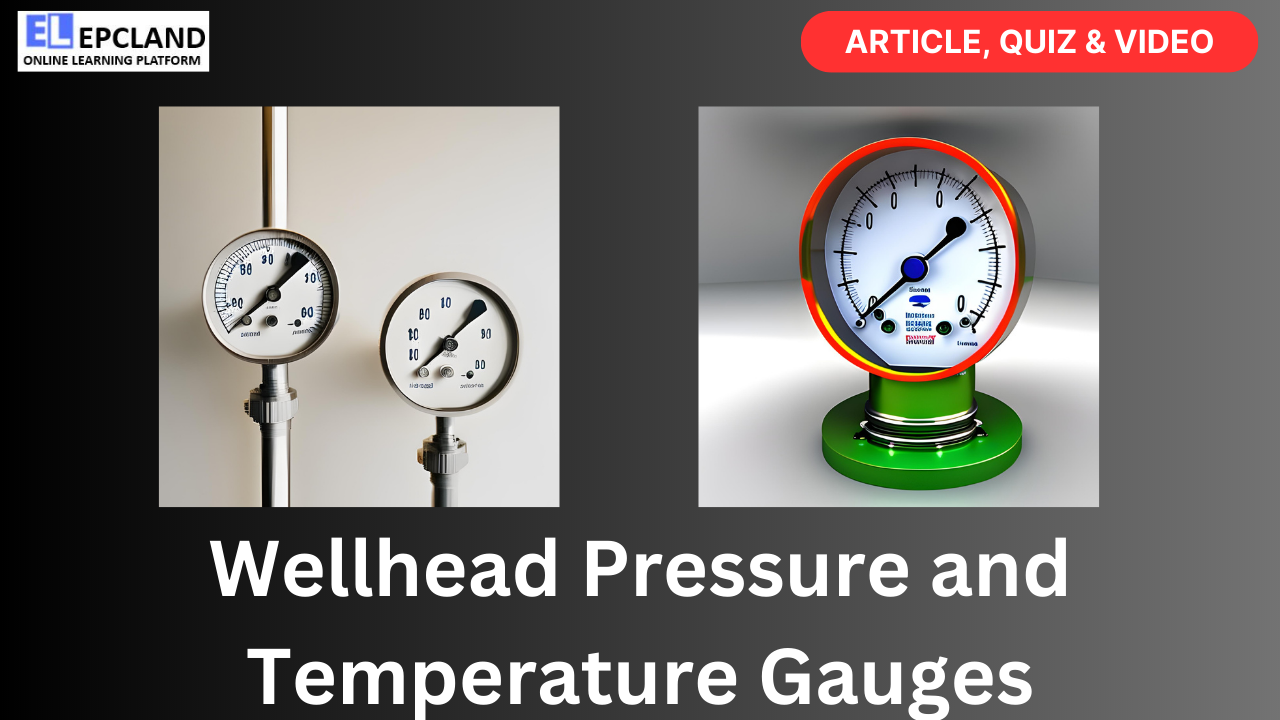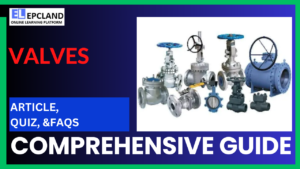Wellhead pressure and temperature gauges are essential instruments in the oil and gas industry, particularly in upstream operations. These gauges play a critical role in ensuring the safe and efficient extraction of hydrocarbons from the earth’s subsurface. In this article, we will explore the significance of wellhead pressure and temperature gauges, their functions, types, installation, and maintenance practices in oil and gas industry projects.
Table of Contents
Do not miss the detailed course 7 Modules of Piping Codes & Standards
Enrollment link
Introduction
The wellhead is a crucial component of oil and gas extraction operations. It is the point where the wellbore, which extends deep into the earth’s crust, meets the surface facilities. At the wellhead, hydrocarbons are brought to the surface, and various parameters, including pressure and temperature, need to be closely monitored and controlled.
Importance of Pressure and Temperature
Pressure and temperature are two fundamental parameters that directly affect the behavior of hydrocarbons. Accurate measurement and control of these parameters are essential for several reasons:
- Safety: Maintaining the right pressure and temperature levels ensures safe working conditions for personnel and equipment. Preventing overpressure and excessive temperatures minimizes the risk of accidents and equipment failures.
- Production Efficiency: Proper control of pressure and temperature helps optimize production rates and the quality of extracted hydrocarbons. It ensures that the reservoir fluids flow smoothly from the wellbore to the surface facilities.
- Environmental Compliance: Regulatory agencies often set strict guidelines for pressure and temperature levels at wellheads to protect the environment. Compliance with these regulations is critical for avoiding fines and legal issues.
Wellhead Pressure Gauges
Functions of Pressure Gauges
Pressure gauges at the wellhead serve several crucial functions:
- Monitoring Well Pressure: Pressure gauges continuously monitor the pressure within the wellbore. This data helps operators assess the reservoir’s condition and any changes in pressure due to production activities.
- Safety: Gauges provide real-time information about pressure levels. If pressure exceeds safe limits, automatic safety systems can be triggered to shut down the well to prevent blowouts and other dangerous situations.
- Production Optimization: Pressure data is used to optimize production rates. Operators can adjust flow rates and other parameters based on the pressure readings to maximize production efficiency.
Types of Pressure Gauges
Several types of pressure gauges are used at wellheads, each with its own advantages and applications:
- Mechanical Pressure Gauges: These traditional gauges use a diaphragm or Bourdon tube to measure pressure. They are reliable and cost-effective but may require regular calibration.
- Electronic Pressure Transmitters: These devices convert pressure into electrical signals. They are highly accurate and offer remote monitoring capabilities, making them suitable for modern wellhead automation systems.
- Submersible Pressure Transducers: Designed for downhole applications, these gauges can withstand high pressures and temperatures in the wellbore. They are used to measure bottomhole pressure.
Installation and Maintenance
Proper installation and maintenance are crucial to the performance of wellhead pressure gauges:
- Location: Gauges should be strategically placed to capture representative pressure data. Common locations include the Christmas tree (a set of valves and fittings at the wellhead) and downstream of choke valves.
- Calibration: Regular calibration ensures the accuracy of pressure gauges. Calibration intervals may vary based on manufacturer recommendations and local regulations.
- Protection: Gauges are often exposed to harsh environmental conditions, including weather and corrosive substances. Protective enclosures and coatings can extend their lifespan.
Wellhead Temperature Gauges
Functions of Temperature Gauges
Temperature gauges at the wellhead serve critical functions:
- Reservoir Monitoring: Temperature data helps assess reservoir conditions. Changes in temperature can indicate variations in fluid composition or the presence of obstructions in the wellbore.
- Equipment Protection: High temperatures can damage equipment and decrease its lifespan. Temperature gauges trigger alarms or shutdowns if equipment temperatures exceed safe limits.
- Fluid Properties: Temperature affects the properties of hydrocarbons. Accurate temperature measurements are essential for calculating fluid density and viscosity, which impact flow rates.
Types of Temperature Gauges
Wellhead temperature gauges are available in various types to suit different applications:
- Bimetallic Thermometers: These simple devices use the expansion and contraction of two dissimilar metals to measure temperature changes. They are reliable but may not be as accurate as electronic sensors.
- Resistance Temperature Detectors (RTDs): RTDs use the change in electrical resistance with temperature to measure temperature accurately. They are commonly used in wellhead applications.
- Thermocouples: Thermocouples are versatile temperature sensors that work based on the voltage generated when two dissimilar metals are joined. They can withstand high temperatures and are often used in downhole applications.
Installation and Maintenance
Proper installation and maintenance practices are essential for wellhead temperature gauges:
- Placement: Temperature gauges should be placed in locations where they can provide representative readings. The choice of placement depends on the specific application and well design.
- Calibration: Like pressure gauges, temperature gauges require periodic calibration to ensure accuracy. Calibration frequency should follow manufacturer guidelines.
- Protection: Temperature sensors are sensitive to environmental conditions. Proper protection, such as heat shields and insulation, is necessary to shield them from extreme temperatures and external factors.
Do not miss the detailed course 7 Modules of Piping Codes & Standards
Enrollment link
Integration with Wellhead Control Systems
Pressure and temperature gauges at the wellhead are often integrated into wellhead control systems. These systems use data from the gauges to make real-time decisions about production rates, safety measures, and equipment protection.
SCADA Systems
Supervisory Control and Data Acquisition (SCADA) systems are commonly used to monitor and control wellhead operations. SCADA systems collect data from pressure and temperature gauges, among other sensors, and provide a centralized interface for operators to monitor and control the wellhead.
Automated Control
Modern wellheads often feature automated control systems that respond to data from pressure and temperature gauges. For example, if the pressure exceeds safe levels, automated valves can shut off flow to prevent a blowout. Similarly, if temperatures rise excessively, equipment can be automatically cooled or shut down to prevent damage.
Challenges and Best Practices
Using pressure and temperature gauges at wellheads comes with challenges and requires adherence to best practices:
Environmental Conditions
Wellheads are often located in harsh environments, including offshore platforms and remote desert locations. Pressure and temperature gauges must withstand extreme temperatures, corrosive substances, and other environmental factors. Wellhead enclosures and protective coatings are essential to ensure their longevity.
Accuracy and Calibration
To ensure the safety and efficiency of wellhead operations, pressure and temperature gauges must be highly accurate. Regular calibration and maintenance are critical to maintaining accuracy and reliability. Calibration schedules should follow manufacturer guidelines and industry standards.
Integration and Data Management
Integrating pressure and temperature data into control systems requires careful planning and robust data management. Data should be transmitted reliably, and control systems should be designed to respond effectively to variations in pressure and temperature.
Conclusion
Wellhead pressure and temperature gauges are indispensable tools in the oil and gas industry. They provide essential data for monitoring well conditions, optimizing production, ensuring safety, and protecting equipment. The choice of gauge types, their proper installation, calibration, and integration into control systems are all critical factors in successful wellhead operations. As technology continues to advance, the role of these gauges in enhancing efficiency and safety in the industry is only set to grow, making them an integral part of every oil and gas project.
Do not miss the detailed course 7 Modules of Piping Codes & Standards
Enrollment link
FAQs
- What is the purpose of wellhead pressure and temperature gauges in the oil and gas industry?Wellhead pressure and temperature gauges are used to monitor and control critical parameters at the wellhead, ensuring safe and efficient oil and gas extraction.
- Why is pressure monitoring important at the wellhead?Pressure monitoring is vital to prevent well blowouts, maintain safety, optimize production rates, and ensure compliance with environmental regulations.
- What types of pressure gauges are commonly used at wellheads?Common types of pressure gauges include mechanical pressure gauges, electronic pressure transmitters, and submersible pressure transducers for downhole applications.
- What role does temperature monitoring play at the wellhead?Temperature monitoring helps assess reservoir conditions, protect equipment from overheating, and calculate fluid properties that impact flow rates.
- What are the different types of temperature gauges used at wellheads?Temperature gauges used at wellheads include bimetallic thermometers, resistance temperature detectors (RTDs), and thermocouples.
- How often should pressure and temperature gauges be calibrated?Calibration frequencies depend on manufacturer recommendations and industry standards but typically range from several months to a year.
- What challenges are associated with using pressure and temperature gauges in wellhead operations?Challenges include harsh environmental conditions, accuracy maintenance, and data integration into control systems.
- How are pressure and temperature gauges integrated into wellhead control systems?Pressure and temperature data are often integrated into Supervisory Control and Data Acquisition (SCADA) systems, which allow operators to monitor and control wellhead operations in real-time.
- What safety measures are in place if pressure or temperature readings exceed safe limits at the wellhead?Automated safety systems can shut off flow or initiate cooling measures if pressure or temperature exceeds safe levels to prevent accidents and equipment damage.
- How do pressure and temperature gauges contribute to the efficiency and sustainability of oil and gas projects?By providing real-time data for control and optimization, pressure and temperature gauges help maximize production efficiency, reduce environmental impact, and enhance overall project sustainability.
Recommended courses (Published on EPCLand)
- Basics of Piping Engineering
- Piping Layout Engineering
- Piping Material Engineering
- Piping Stress Analysis
- Complete Course on Piping Engineering
- Material Requisitions
- Piping Material Specifications
- Valve Material Specifications
Don’t miss the published articles on following:
| Industrial Applications with Link | Industrial Applications with Link |
| Corrosion Monitoring Instruments | Safety Instrumented Systems |
| Instrumentation in Renewable Energy | Safety Relief Valves |
| Orifice Plate in the Oil & Gas Industry | Well Test Instruments |
| Wellhead Pressure and Temperature Gauges | Wireless Instrumentation in Oil & Gas Projects |
Related Video
Attempt Quiz
Question 1:
What is the primary purpose of a wellhead pressure gauge in the oil & gas industry?
Explanation: The primary purpose of a wellhead pressure gauge is to measure the pressure inside the wellbore.
Question 2:
Which unit of measurement is commonly used for wellhead pressure in the oil & gas industry?
Explanation: Wellhead pressure is commonly measured in pounds per square inch (psi).
Question 3:
Why is it important to monitor wellhead temperature in the oil & gas industry?
Explanation: Monitoring wellhead temperature is important to prevent equipment damage and ensure safety in the oil & gas industry.
Question 4:
Which type of gauge is commonly used to measure wellhead pressure and temperature simultaneously?
Explanation: A dual-purpose gauge is commonly used to measure wellhead pressure and temperature simultaneously.
Question 5:
Which industry safety standards are often followed for the installation and maintenance of wellhead pressure and temperature gauges?
Explanation: Wellhead pressure and temperature gauge installations often follow API (American Petroleum Institute) standards for safety and reliability.



